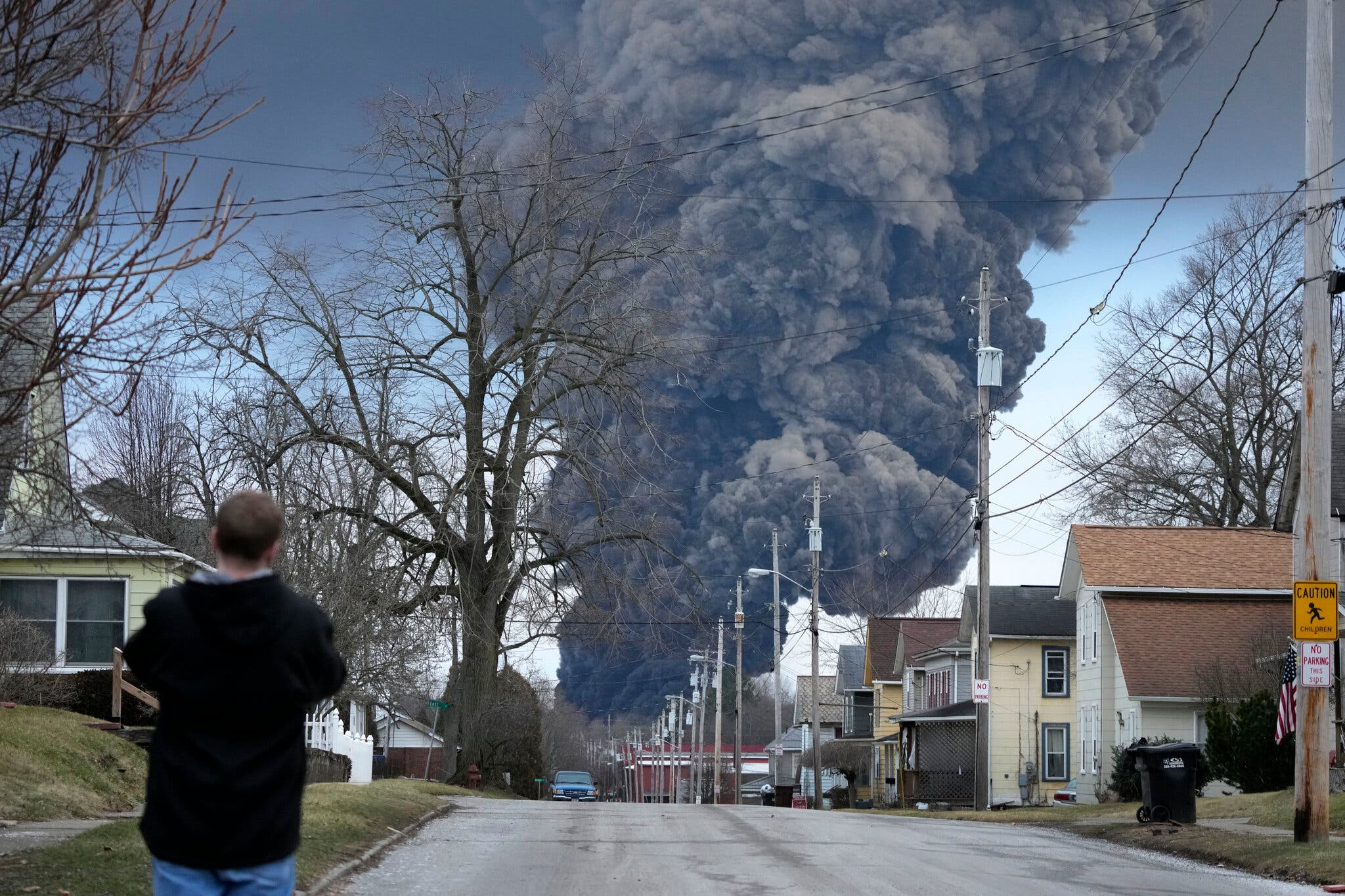Ohio Train Derailment: Lingering Toxic Chemicals In Buildings

Table of Contents
Pathways of Chemical Contamination in Buildings
The toxic chemicals released during the derailment found their way into East Palestine homes and buildings through various pathways, creating a complex and persistent contamination issue.
Airborne Contamination:
Volatile organic compounds (VOCs), such as vinyl chloride and butyl acrylate – known carcinogens and respiratory irritants – were released into the air during the derailment and subsequent fire. These VOCs, invisible and odorless in many cases, infiltrated buildings through:
- Open windows and doors
- HVAC systems and ventilation shafts
- Cracks and gaps in building structures
These VOCs didn't simply dissipate. Many absorbed into building materials like:
- Carpets and upholstery
- Drywall and insulation
- Fabrics and porous surfaces
This absorption creates a reservoir of toxins, leading to prolonged exposure for residents even after the immediate air quality improves. The long-term health implications of this continuous, low-level exposure are still being investigated.
Surface Contamination:
Fine particulate matter containing toxic chemicals settled on various surfaces within buildings, including:
- Floors and countertops
- Furniture and appliances
- Window sills and other surfaces
Simple cleaning may not be sufficient to eliminate these deeply embedded contaminants. The microscopic particles can adhere to surfaces and be easily re-suspended into the air through normal activity, leading to repeated inhalation. Professional remediation, employing specialized cleaning techniques, is vital for effective removal and long-term safety.
Water Contamination:
Runoff from the derailment site contaminated local water sources, raising concerns about the potential for contaminated water entering building plumbing systems. This poses a serious threat through:
- Contaminated well water sources
- Potential leaching of chemicals into municipal water supplies
- Backflow into plumbing systems
Extensive testing of water sources and plumbing systems in affected buildings is crucial. Replacement of affected pipes and fixtures may be necessary to ensure the long-term safety of the water supply.
Health Risks Associated with Lingering Chemicals
The presence of lingering toxic chemicals in buildings poses significant health risks to residents, particularly vulnerable populations like children and the elderly.
Respiratory Issues:
Exposure to VOCs and other airborne contaminants can cause a range of respiratory problems, including:
- Coughing and wheezing
- Shortness of breath
- Asthma attacks and exacerbations
- Increased susceptibility to respiratory infections
Long-term exposure can lead to chronic obstructive pulmonary disease (COPD) and other serious lung conditions.
Neurological Effects:
Some of the chemicals released during the derailment are known neurotoxins, capable of causing:
- Headaches and dizziness
- Cognitive impairment and memory loss
- Tremors and other neurological symptoms
The long-term neurological impact of exposure to this complex mixture of chemicals remains largely unknown, highlighting the urgent need for ongoing research and monitoring.
Cancer Risks:
Exposure to certain chemicals released during the derailment, notably vinyl chloride, is a known carcinogen significantly increasing the risk of various cancers, including:
- Liver cancer
- Lung cancer
- Brain cancer
Long-term health monitoring of affected residents is vital for early detection of potential health problems and to understand the full extent of the cancer risk.
The Need for Comprehensive Testing and Remediation
Addressing the lingering threat of Ohio train derailment toxic chemicals in buildings requires a multifaceted approach focused on testing, remediation, and ongoing monitoring.
Independent Testing:
Independent, third-party testing of affected buildings is crucial to provide unbiased assessments of the extent of contamination and to ensure the accuracy of findings. This includes testing for a wide range of chemicals and contaminants.
Professional Remediation:
Professional remediation services are essential to safely and effectively remove the lingering toxic chemicals from affected buildings. This process must be rigorously monitored and validated.
Government Oversight:
Strong government oversight and regulation are essential to ensure that remediation efforts are thorough, effective, and comply with safety standards. This includes transparent reporting and public access to testing results.
Transparency and Public Access to Information:
Open communication and transparent access to detailed testing results are crucial for building public trust and enabling informed decision-making by residents and policymakers alike. The public has a right to know the extent of the contamination and the steps being taken to address it.
Conclusion:
The Ohio train derailment’s impact extends far beyond the immediate site, with lingering toxic chemicals in buildings posing a significant long-term health and environmental risk to residents of East Palestine. Addressing this issue requires comprehensive testing, professional remediation, and ongoing monitoring. The long-term health consequences of exposure to these chemicals necessitate robust government support, including access to healthcare and transparent communication. Ignoring the lingering threat of Ohio Train Derailment toxic chemicals in buildings will only exacerbate the already devastating consequences of this disaster. Demand action from your local representatives to ensure the safety and well-being of the East Palestine community and demand thorough testing and remediation of affected buildings. The health and future of the community depend on it.

Featured Posts
-
 Tanzania And South Africa Trade Talks Progress On Lifting Farm Import Ban
Apr 27, 2025
Tanzania And South Africa Trade Talks Progress On Lifting Farm Import Ban
Apr 27, 2025 -
 Neuer Atlas Zeigt Die Amphibien Und Reptilien Thueringens
Apr 27, 2025
Neuer Atlas Zeigt Die Amphibien Und Reptilien Thueringens
Apr 27, 2025 -
 Open Thread February 16 2025 Discussion
Apr 27, 2025
Open Thread February 16 2025 Discussion
Apr 27, 2025 -
 How To Buy Ariana Grandes Lovenote Fragrance Set Online Pricing And Availability
Apr 27, 2025
How To Buy Ariana Grandes Lovenote Fragrance Set Online Pricing And Availability
Apr 27, 2025 -
 February 20 2025 Your Happy Day Checklist
Apr 27, 2025
February 20 2025 Your Happy Day Checklist
Apr 27, 2025
